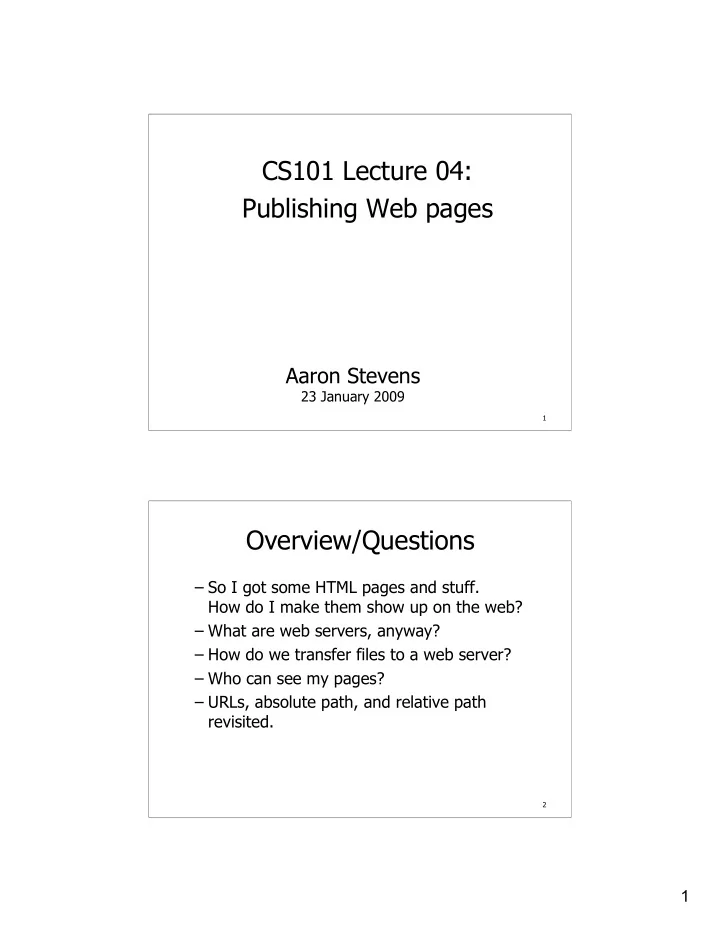

CS101 Lecture 04: Publishing Web pages Aaron Stevens 23 January 2009 1 Overview/Questions – So I got some HTML pages and stuff. How do I make them show up on the web? – What are web servers, anyway? – How do we transfer files to a web server? – Who can see my pages? – URLs, absolute path, and relative path revisited. 2 1
How to Publish a Web Page Create HTML document, locate ancillary files (e.g images). Transfer files to web server Set permissions for read access Test the URL in your browser 3 Recall: Displaying a WWW Page 4 2
What’s a Web Server? Web server: a software application which waits for /responds to HTTP requests. Tim Berners-Lee wrote 2 applications to make the web: – A web browser called WorldWideWeb – A server called HTTPd 5 The first WWW Server at CERN. What’s a Web Server? Today’s web servers use high-performance hardware like this: (fast network and disk access) Pictured: IBM Blade Servers hosting files.myopera.com, photo from Wikipedia 6 3
What’s a web server? The Apache HTTP Server is the most popular web server (since 1996). Roles: – Processing HyperText Transfer Protocol – Logging – Delivering static content from the file system – Running scripts to deliver dynamic content 7 LAMP Model The most common structure for web applications uses this configuration: Linux operating system for a server Apache web server software MySQL database software PHP/Perl/Python scripting language to create dynamic HTML 8 4
How a Web Server Works Receives HTTP Request Search for resource (file) on disk Send HTTP Response (status code + data) – If not found: status 404 (NOT FOUND) – If not permitted: status 403 (FORBIDDEN) – … – Else: status 200 (OK) + send data 9 cs-people.bu.edu Our WWW server is cs-people.bu.edu . The web server has a file system which it searches for a URI (resource pathnames). – /var/www/html/ maps to http://cs-people.bu.edu/ – Subdirectories for individual users: http://cs-people.bu.edu/<username> – Example: http://cs-people.bu.edu/azs 10 5
Your UNIX Home Directory With the CS UNIX account, each user has a “home” directory: General form: /cs/course/<section>/<username>/ Example: /cs/course/cs101a2/azs/ This has a UNIX pseudonym of ~. Also mapped to your Windows Z:/ drive. 11 Your WWW Directory The web server will map this URL: http://cs-people.bu.edu/<username>/ to your CS UNIX’s account’s ~/public_html/ directory (or Z:/public_html/ on Windows). 12 6
Locate files in Finder/Windows Explorer Find your files on your local computer 13 How to Transfer Files to csa2.bu.edu Use a file transfer client-program: – Fetch (Mac) http://fetchsoftworks.com/ (a free academic license is available) – WinSCP (Windows) http://winscp.net/eng/index.php (also free) 14 7
Connecting by WinSCP: – Hostname: csa2.bu.edu – Be sure to use the “SFTP” protocol 15 WinSCP to csa2.bu.edu After you connect, transfer files by drag’n’drop. Then right- click to set permissions. 16 8
File Protection Users and Groups Many operating systems (for example, Unix) have a concept of users (each with unique username/password). Users are organized into groups. Example: I’m in all of these groups: faculty3 cs108grades cs101stuff cs108stuff cs101grades Example: you are in one of these group: cs101a2, cs101a3, cs101a4, cs101a5, cs101b2, cs101b3 or cs101b4 17 File Permissions File Permissions Each file has its own set of permissions for: – Reading, writing or executing – Owner, group, or others – This leads to a 3x3 matrix of permissions: 18 9
Setting Permissions by WinSCP Right-click to open this dialog Set the permissions to 644 19 Transferring File by Fetch Use drag’n’drop interface to transfer files… Then use the Get Info button to set permissions. 20 10
Setting Permissions by Fetch Set permissions to 644 21 Testing the Webpage: After uploading the files, test in your browser: There are two special filenames that the web server looks for automatically: – home.html – index.html 22 11
Take-Away Points – Web server – UNIX home directory – File Transfer Protocol – UNIX File Permissions 23 Student To Dos – Readings for this week: Reed ch 2, pp 27-35 HTML Tutorial http://www.w3schools.com/HTML/ – HW 2 due Tuesday 1/27 24 12
Recommend
More recommend